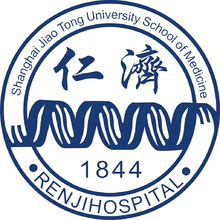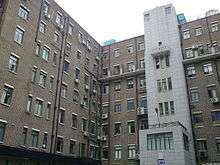Renji Hospital
| Renji Hospital | |
|---|---|
 | |
| Geography | |
| Location | Huangpu District, Pudong New Area and Minhang District, Shanghai, PRC |
| Organisation | |
| Care system | Public |
| Hospital type | Teaching |
| Affiliated university | Shanghai Jiao Tong University |
| Services | |
| Standards | Grade 3, Class A (Chinese: 三级甲等) |
| Emergency department | Yes in Pudong, No in Puxi |
| Beds | 1600 |
| History | |
| Founded | 1844 |
| Links | |
| Website | http://www.renji.com/ |
| Other links | Shanghai Jiao Tong University School of Medicine |
Renji Hospital (simplified Chinese: 仁济医院; traditional Chinese: 仁濟醫院; pinyin: Rénjì Yīyuàn) is a general hospital in the Huangpu District of Shanghai, China, with the rank of "Grade 3, Class A". The hospital is a university hospital affiliated to Shanghai Jiao Tong University School of Medicine.
History

It was the first western hospital in Shanghai and the second in China. William Lockhart,[1] a missionary from Britain, rented a house in the inhabited area near Da Dong Men (Big East Gate) of Shanghai County and opened this hospital in 1844, the 24th year of the Qing dynasty Daoguang Emperor. It was at that time known as 'the Chinese Hospital'. Two years later, the hospital moved to Mai Jia Quan (now Middle Shandong Road), and changed its name to Shantung Road Hospital also called Renji Yi Guan (仁济医馆).[2] Renji had 60 beds and started an out-patient clinic. In 1927, the 16th year of the Republican era, the hospital received a legacy from the British merchant, Henry Lester, comprising one million taels of silver and four lots of real estate, which were used to expand the hospital. In 1932, a six floor building was constructed for the hospital, and the number of beds was increased to 250. It became Renji Hospital, although some people called it the Lester Chinese Hospital. Renji Hospital had 300 beds in 1949.
In November 1952, Shanghai Second Medical College took over control of Renji Hospital from East China Health Care Administration and called Renji Hospital Affiliated to Shanghai Second Medical College. In the 'Cultural Revolution', the hospital once changed its name to 'Gong Nong Bing Hospital' (workers, farmers and armymen's hospital) and 'The 3rd People's Hospital'. In Dec. 1984, the hospital regained to its former name Renji. In 1985, Shanghai Second Medical College renamed as Shanghai Second Medical University (SSMU), then Renji Hospital became an affiliated hospital of SSMU. At the end of 1990, Renji had 607 beds and 1,211 staff members.[3] In 2005, Shanghai Second Medical University was merged to Shanghai Jiao Tong University and Renji Hospital then became an affiliated hospital of Shanghai Jiao Tong University School of Medicine.[4]
Present

As Pudong became an open economic development zone, Renji chose a new place for its extension in Lujiazui. Now, Renji Hospital has three parts, the west part is the old place in Puxi, the east part is in Pudong New Area, and the south part is in Pujiang Town, Minhang District. There is only an out-patient clinic in the south part.
Up till 2007, the campus space is 24.2 acres (98,000 m2) and the building space is 185,744 square meters. Renji Hospital has 1,600 patient-beds. The hospital has 2,651 employees, among them 411 are senior doctors. It treats about 2,170,000 emergency cases and outpatients, about 57,000 inpatients and over 28,000 operations every year. Shanghai Institute of Digestive Disease[5] is in Renji hospital.
Gastroenterology is a national key discipline. It is also known for rheumatology, cardiology, obstetrics, gynecology, andrology, nephrology, hematology, general surgery, neurosurgery and cardiothoracic surgery.
Notable professors
- Lan Xichun (Chinese:兰锡纯) (1907–1995)
- Huang Mingxin (Chinese:黄铭新) (1909–2001)
- Jiang Shaoji (Chinese:江绍基) (1919–1995)
Transport
East part (No. 1630, Dongfang Road)
- Metro Line 4, Tangqiao Station
- Metro Line 6, Shanghai Children's Medical Center Station
- Bus: 614, 789, 871, 984, 980, 219, Tunnel Line 9
West part (No. 145, Middle Shandong Road)
- Metro Line 2, Metro Line 10, East Nanjing Road Station
- Bus: 14, 17, 66, 145, 220, 864, 980, Tunnel Line 3, Tunnel Line 6, Tunnel Line 9
South part (No. 2000, Jiangyue Road)
See also
References
- ↑ Lockhart, William (1861) The medical missionary in China: a narrative of twenty years' experience
- ↑ E.S.Elliston, Ninety-five Years:A Shanghai Hospital, 1844-1938.
- ↑ Shanghai Local Archive Office(Chinese)
- ↑ Introduction from Renji Official Website(Chinese)
- ↑ Introduction of Shanghai Institute of Digestive Disease(Chinese)
Coordinates: 31°13′59″N 121°29′02″E / 31.233°N 121.484°E